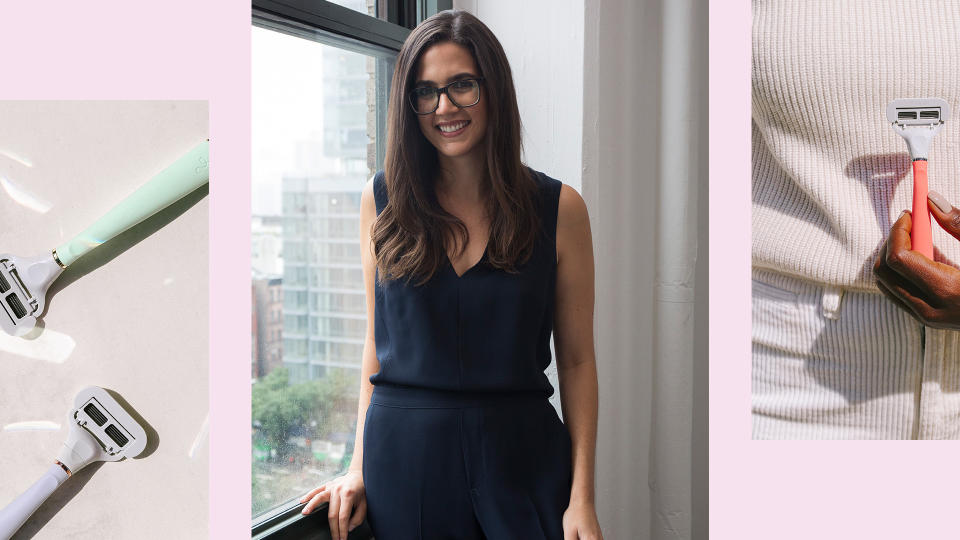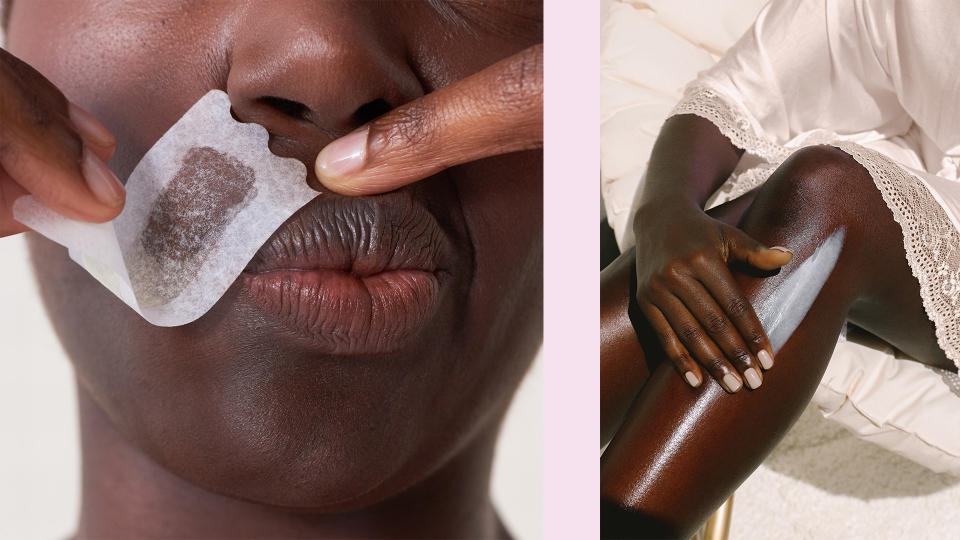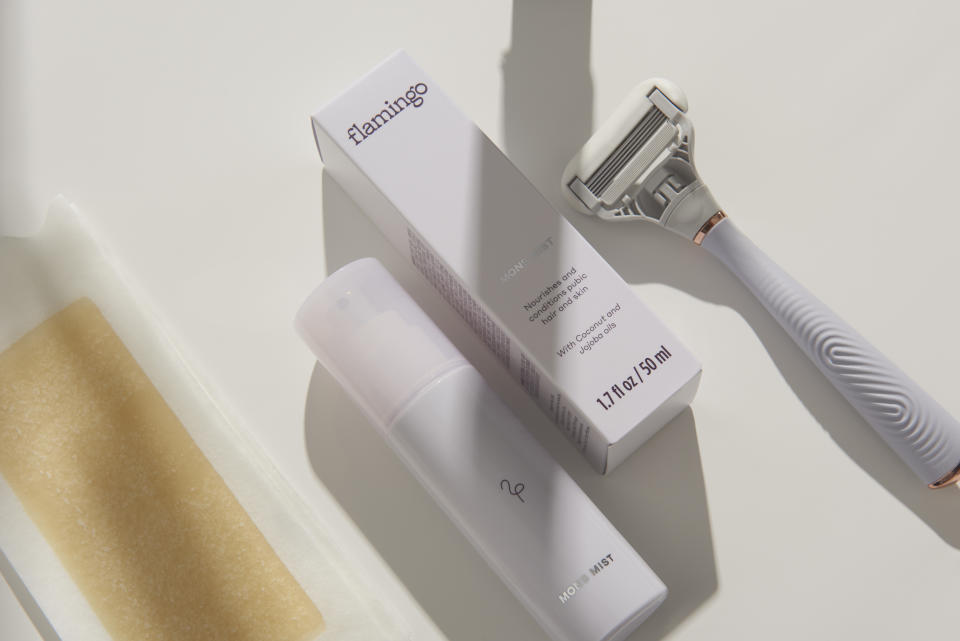Bush 2020? This campaign is NOT what you think
We may receive a share from purchases made via links on this page. Pricing and availability is subject to change.
Grooming brand Flamingo is done beating around the bush, tackling the stigma around women’s body hair one prickly conversation — and innovative product — at a time.
“A lot of it started, frankly, with me telling my own body hair stories — which has been such a quiet, taboo, uncomfortable space,” Allie Melnick, the company’s general manager, tells MAKERS. “I was very open with the fact that I have body hair. It's not just under my arms. It's on my chin and I have a mustache.”

These frank discussions, especially those with co-workers at Harry’s Inc., inspired Melnick to launch Flamingo out of Harry’s Labs to provide women with superior hair removal tools. While the razors, shaving cream, lotion and wax kits created by the brand are first-rate, it’s the messaging and marketing that has attracted more than 1.5 million unique customers around the world.
MAKERS talked to Melnick about the success behind Flamingo, which is about so much more than making money.

MAKERS: How did the idea of this women’s grooming brand come about coming from Harry’s, a men’s grooming company?
Allie Melnick: If you looked around our office in the beginning, myself included, every woman in our office was using a Harry's product, which was great, but also not really designed with our needs in mind. We started to do a lot of listening and learning with women within our office, talking to thousands of women outside of our office and really gut checking — am I alone in feeling this market isn’t speaking to me? And the short answer is no.
So we really went on a journey of how to create a better experience for women, being honest about their needs and really taking what's uncomfortable and making it more comfortable. Body hair and a lot of aspects of your body, frankly, are things that are just so true to who you are, and everyone's experience is so personal, but it's something that women don't always feel comfortable about.
I really wanted to bring that conversation out in the open and support an honest conversation and really thinking about choice in that narrative, too. So in bringing Flamingo to life, we wanted to be really honest about understanding women's needs. No two women are the same. Their choices are their own.
When you look at how you think about grooming and removing, what tools are used are very individualized and not all the same. We wanted to create a grooming product that really supports this idea of choice and also supports women in whatever needs and however they choose to groom and take care of themselves.
Flamingo makes a few products and does them really well. How did you decide what to do and how to execute it?
I think what I'm really proud of is Flamingo is the first brand to really offer options and choices. Not just razors, but also wax kits and Mons Mist, because whether you grow it or remove it sometimes you want options. One of the first things that we learned was that 70 percent of women are using two or more different types of tools when they choose to remove hair, so it's not just razors.
I think, in general, the way that we approach product development is really starting by listening and understanding women's needs, and really where they need support, and then building thoughtfully for that.
Our suite is thinking about different tools. We have the razor, but also thought about the care that comes around it. We have our shave gel, which is super hydrating and conditioning, and lotion, thinking about the care that comes afterward. Flamingo also has wax kits because, actually, there are different types of ways to remove hair.
When it comes to at-home waxing, 40 percent of Flamingo wax customers have never waxed before (at home or professionally), while 60 percent have never waxed at home before, which I think is amazing. This idea of choice is so inherent in what feels right and what is true. In launching Mons Mist, it was really understanding that there are these spaces and there are these preferences that you have. And again, the majority of women are not always removing hair in their pubic area. Sometimes they're growing it out. Sometimes they're removing some of it, but keeping some of it and shaving just their bikini line.

The company's mission is to decrease body hair stigma and get women to become more comfortable with their natural bodies. Where do you think this stigma comes from and how is Flamingo addressing it?
I think our culture has this archaic view of what it means to be feminine and what it means to be a woman. And I think certainly what we saw when we first started this journey was a really antiquated view of femininity that was being put out for decades and decades that women are hairless, poreless goddesses under a waterfall — and that's just not true. It's not true to anyone's experience.
That idea has manifested in so many different ways and different categories, but certainly in women’s grooming. It felt like there was a real opportunity to let an honest conversation happen and take some of that shame and stigma away and reveal the truth that women have hair. Women have hair all over, and all different types. It doesn't make you any more or less feminine.
But also because it's been so stigmatized there's just a lot of questions and women are really left navigating it on their own in the dark, kind of confused and embarrassed. Being a brand that actually brings that conversation out into the open is really important.
And that's something else that has been really important in this is then really supporting you along the way so that you feel supported in your choices. We also wanted to be a resource for customers with tools and education because it's been so quiet and hidden away.
Speaking of education, Flamingo offers a free wax guide. Tell us more about this part of the Flamingo brand and why you wanted to make making at-home waxing easy.
I think a big piece of our waxing guide was how do we make sure we're setting a woman up for success in that they feel confident? And then how do we make sure the products themselves are fitting into her routine? And those are the two areas that were really important.
On setting her up for success, we really dove deeply into instructions and how to educate. The other thing we wanted to show was convenience. It’s amazing. It’s why I wax at home now every other week — and it's on your schedule.
Another thing that we found was actually a lot of products were time-consuming. You have to heat them up in your hands or in the microwave. So how do you really give her that convenient experience? That’s why our products are ready to use wax kits. You just pull them apart and you're good to go, saving your time.
We also wanted to address that any time you remove hair from your body, your skin goes through trauma. And so how do you think about the care aspect of it and actually supporting the skin after that experience? We have two main post-wax cloths that are using oils to think about removing, but then also caring for the skin, like the lavender calming serum. So thinking about cooling and calming the skin and really caring for it so that not only are you getting the results you want, but you're also caring about your body, too.
The Bush 2020 campaign tackling pubic hair is incredible — tell us more about the inception of this campaign and what the response has been like.
One area that we heard was another quiet space is the pubic region. And going deep there with women, what we heard is actually you're in all sorts of stages of removing and growing. Like I was talking to my mother the other day, and I fell into a conversation with her and her friends about conditioning — pubic hair conditioning.
So we had a wacky idea that turned into a real campaign that we're super proud of, which was the Bush 2020. It’s all about choice and all about taking this topic, adding some levity, but also just putting it out there and having a conversation around it. We did a full-page national ad in The New York Times with our pubic service announcement. We had a campaign headquarters on Canal Street in New York City so that people could come in and experience the brand and the products. We had activations in that space, too. We had a gynecologist come in and do what we call “tipsy anatomy” to just answer questions.
For us, it was really an amazing opportunity to also speak intelligently. It wasn't dumbed down. There's a lot of euphemisms in this space, but we actually wanted to be anatomically correct in how we named the product and how we talked about it. I think it's just really opened up so much dialogue and taken the stigma away. And that was the big goal of this: to really support women, supporting the care for their bodies and not feeling ashamed by it. We're really proud of it.
